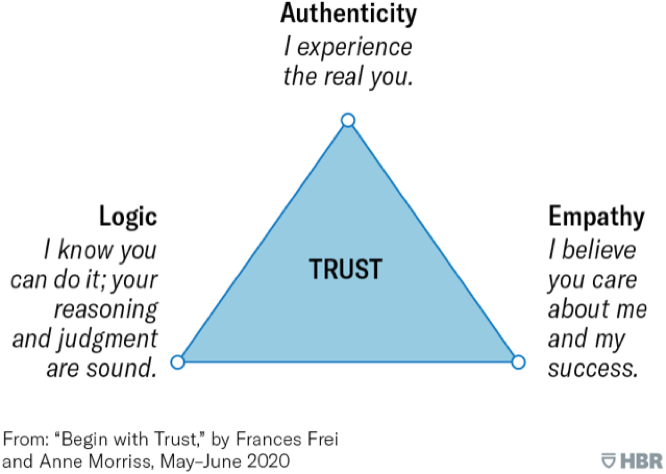Business Bites: Empowerment and trust

Empower your teams to be the best they can be
It could be said that a common trait in leadership is to take charge. More and more though, we hear about the importance of authenticity and empathy in the role of a leader.
So is it take charge or take care? The answer is both, and balance is the key, especially when in times of stress when you may find yourself edging towards the take charge persona.
So how should you empower others to give more authority and power and to take more control and be more independent? The answer is by delegating appropriately through empowerment leadership. By empowering members of the team, you create conditions for people to fully realise their own capacity and power.
Empowerment also requires trust. Trust is one of the most essential forms of capital a leader has. Building trust, however, often requires thinking about leadership from a new perspective.
Empowering others
Frei and Morris write: “The traditional leadership narrative is all about you: your vision and strategy; your ability to make the tough calls and rally the troops; your talents, your charisma, your heroic moments of courage and instinct. But leadership really isn’t about you. It’s about empowering other people as a result of your presence, and about making sure that the impact of your leadership continues into your absence“1.
Heathfield adds: “The credo of an empowering manager is to create a work environment in which people are empowered, productive, contributing and happy. Instead of hobbling employees by limiting their tools or information, trust them to do the right thing, get out of their way, and then watch them catch fire“2.
Heathfield’s 10 important principles for managing people that reinforces empowerment are:
1. Demonstrate that you value people. Have regard for your team. Facial expressions, body language and your words express what you are thinking about the people that report to you.
2. Share leadership vision. Help the team feel they are part of the bigger picture, include them in the planning on the product/service and department.
3. Share goals and direction. When possible include the team in goal setting at department level; they can add value, knowledge, ideas and experience. Progress on goals should be measurable and observable.
4. Trust people. When the team receive clear expectations, they relax and trust you, focusing their energy on accomplishing work and not worrying and second-guessing.
5. Provide information for decision making. Make certain that people have, or can gain access to, all the information needed to make thoughtful decisions.
6. Don’t just delegate the drudge work. You need to make work enjoyable, so be sure to delegate some of the fun stuff and assignments that you know a person is interested in. Some of the fun, interesting work you can delegate, includes the projects that people and customers notice.
7. Provide frequent feedback. Provide feedback so that the team know how they are doing. People deserve constructive feedback, so they can continue to develop their knowledge and skills.
8. Solve problems. Don’t pinpoint problem people. When a problem occurs, ask what is wrong with the work system that caused the team to fail – not what is wrong with the people.
9. Listen to learn and ask questions. Provide a space in which people will communicate by listening to them and asking questions. Ask their opinions and trust their judgements.
10. Help employees feel rewarded and recognised. Basic needs of employees must feel met for employees to go above and beyond what is expected. Recognition plays a big part.
Another important part of managing in this way is participative leadership. When individuals come to you to discuss an issue, establish what they need from you and don’t make any assumptions. Is it?
• For support
• For advice
• For information
• For a decision
Trusting others
We’ve heard trust mentioned many times already and will look at how this important behaviour comes from a place of compassion and empathy. Kindness is not weakness. Empathy can be learned and monitored; it isn’t something that has to come naturally and all can acquire this skill.
An interesting way to consider trust is to use the Trust Triangle1. The three drivers of trust, authenticity, logic and empathy can be summarised as follows:

Frei and Morris also talk about the concept of a Trust Wobble when we may start to slip in one or more of the areas above. This can be more amplified as mentioned earlier when you are under stress. By reviewing your own thoughts, feelings and actions, you can learn to identify your own ‘wobbles’ and look to see if there are patterns in when they appear, e.g. when you deal with a superior vs. when you deal with one of your team.
So what may these wobbles look like and what may be their impact?
Empathy
We have already seen that this is when people feel that you care about them and what they have to offer. A wobble in this area may happen when you have may be so set on delivering your own agenda that you then switch off when other people are talking about areas that they believe are equally important. Do you find yourself reaching for the laptop or phone whilst others are still speaking? Be present.
Authenticity
People believe that they are working with the real you and not some persona that you wear just for work. When people feel that you are being less authentic or concealing the truth, this will act to put an artificial cap on their trust in you. Be honest.
Logic
Your people have faith in your judgement and competence. This can appear for one of two reasons:
a) They may not believe your data. To prevent this, make sure that you have fully prepared and can back up your data and assumptions
b) You are not communicating effectively. You may need to consider various routes to overcome this. One may be ‘storytelling’ where you can take people on a journey and engage them whilst being clear about your objective and the facets that will enable it. Be engaging and informed.
Summary
Leadership character
Character can’t be faked. It is an aspect of one’s personality that can be evolved and honed, but it’s not something you can fake, at least not for long. In a values-based organisation, projecting a character of fairness, equality and patience encourages others to embrace the same behaviors3.
Building an environment of trust
This is the part of your company culture that, without it, it may falter. Trust in the leadership, one another and the path you’re all on together will determine how productive your teams will be. Simply put, if they don’t trust you, they most certainly won’t follow you – at least not wholeheartedly3.
Empowerment requires the building of trust. Appropriate delegation can empower your team.
References
1. Frei FX and Morriss A. Begin with trust. Harvard Business Review May-June 2020.
2. Heathfield SM. Top 10 principles of employee empowerment. Empower employees to ensure success. The Balance Careers. 3 April 2020.
3. Gamb M. The five components that values-based organisations needs to attract millennials. The Institute of Leadership and Management.